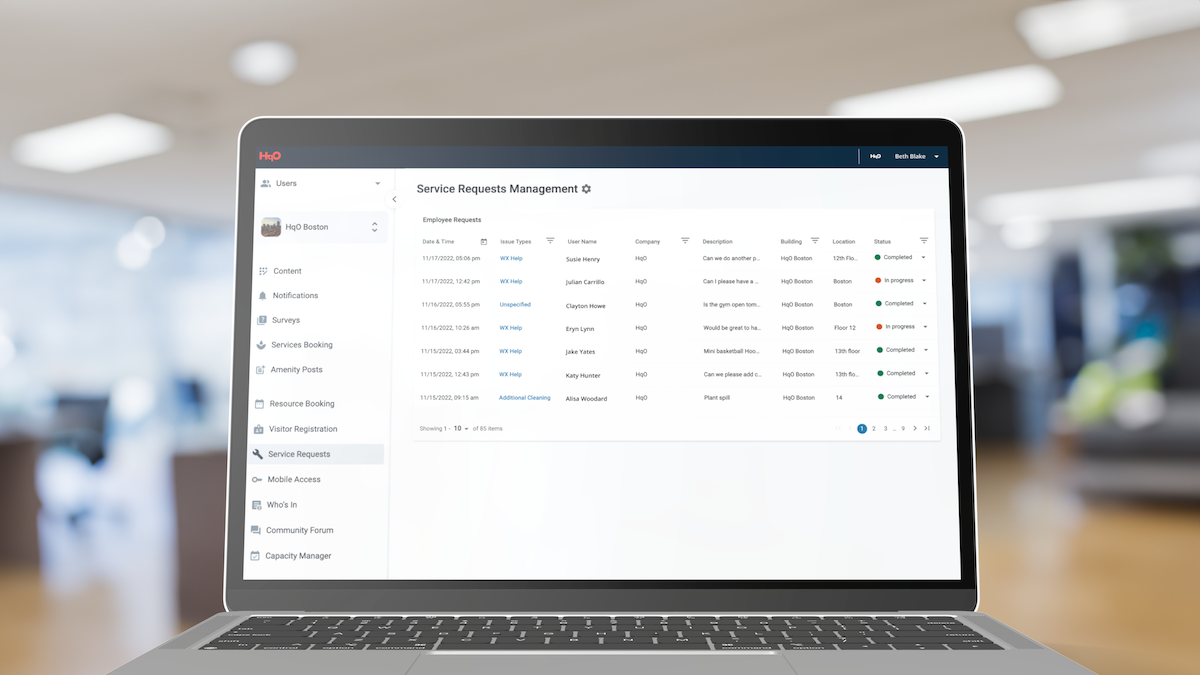Due to the immense pressure commercial real estate operators are feeling from higher interest rates and lower demand due to the secular shift in the way people work, many of our clients are looking for ways to cut costs. Recently, we’ve seen a handful of consulting groups and service firms push operators to consider switching certain IT systems — specifically work order systems — in order to save money.
At HqO, we have successfully deployed digital work order workflows at several hundred properties either integrating with all of the top work order management systems — BuildingEngines, Angus / MRI, Yardi, to name a few — or in rare instances using our own native solution. From this experience, we want to share our learnings to help operators make the right tech priorities in what is a very turbulent environment.
True Costs
“In this tough environment, our company can come in and provide an all-in-one solution for your property teams to handle all of their key workflows, including both work orders and front-of-house experience, AND we can do it for less money than all the other providers that play in this space!”
Ever gotten that pitch? Many operators have and boy does it sound sweet as we all are trying to bring down operating expenses. When considering moving off of the tried and true work order systems like BuildingEnginers, Angus, Yardi, or others we recommend that operators consider all of the costs they will take on and not just the sticker prices of the providers.
Work order costs don’t move the needle on NOI. Typically work order systems run from $.01/square foot to $.03/square foot (need per meter pricing) depending on the features and market. From this starting point, it is incredibly difficult to justify an impact on NOI purely by switching to a lower-cost provider. Regardless of the asset size and rental rates, it is almost impossible to show this impact in your discounted cash flow model if it isn’t part of a much, much larger IT and hard tech consolidation targeting real cost savings.
Switching costs. If you do believe the delta in sticker price is potentially worth the switch, the next step is to factor in the switching costs.
- How much time has been invested into the current system?
- Are there custom workflows by property and by tenant? How long did they take to operationalize?
- Are there integrations with your accounting systems? What were the costs not just of the technical integration but the configuration?
- How seamless is it to move over historical work order data? What is the success rate and fidelity?
- Is your IT team responsible for the switch? How much time from the PM team will it require to ensure the new system achieves parity with the current system?
- Does the new provider provide support staff to make the switch? How much do they cost? If they aren’t charging you for it, how are they covering this cost?
These are all critical questions to answer when considering a switch.
Change management and training
If you can make the math work on the switching costs, the next step is to factor in the change management and training costs of your people with the new system. It’s critical to understand the time it will take to get your people back to par on using the new work order system. Some critical questions to consider include:
- Is our goal to get our people into a comparable workflow that saves us a cent or two per square foot? If so, what amount of time will this take to retrain all of the PMs and engineers?
- Does the system support all of the workflows outside of just the ticketing between a tenant to the PM, including workflows for engineers and vendors? If so how many total people will need to be retrained?
- Does the provider have a full training and enablement team? How many people have they trained successfully and what is the feedback from the PMs and engineers on the front lines?
- What are the costs of training and onboarding? If it does not cost anything how is it supported?
Persona and stakeholder responsibilities
Once you’ve justified the ROI, switching costs, and change management — the next question when considering PM and work order systems within the context of Experience solutions is the objectives of the different personas and stakeholders you need to consider.
In the typical PM workflow, most interactions with tenants are limited to just one or two points of contact that have access to submit a work order. The critical evolution we are seeing in CRE is that the employee experience now requires its own set of workflows and needs to be monitored as a key indicator of tenant health in addition to the point of contact relationship. Across the industry, most organizations are splitting these responsibilities with property management focused on the traditional tenant point of contact workflows and experience managers (sometimes called community managers, concierge, customer success, and at times owned by marketing) owning the workflows and experiences targeting the 99% of the building population that doesn’t submit work orders and probably does not even know who their landlord is.
We see there are critical overlaps where data needs to be shared between these two groups in order to get a full picture of the health of a tenant, but we have yet to see a traditional PM team that has the bandwidth to take on experience management on top of all the responsibilities of traditional property management. So it is critical when evaluating PM and XM offerings to have a clear strategy for how you engage and service the tenant point of contacts and how you engage the broader tenant employee base. Typically we see that with the tenant point of contact, the relationship with the landlord is going to be viewed as a cost center and will be focused on the basic blocking and tackling of what’s expected out of building performance. With the broader employee base, this is the opportunity for operators to be seen as a value driver with the C-suite. By developing a strategy to drive employee engagement at your properties, asset managers can position themselves as partners to their tenants in one of the most impactful parts of any company’s business — employee retention and productivity.
Next steps
The ground is moving very quickly underneath the CRE industry and it is critical to move quickly to address evolving tenant needs. However, many pieces of the CRE business are not broken and it is important not to panic and over-rotate. As you and your organization evaluate your tenant experience strategy be sure to read our resources or reach out to one of our experience consultants for a free one-hour assessment conversation.



